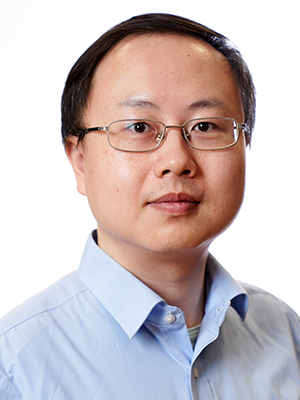Biomolecular Modeling Lab

The research of our lab focuses on developing biomolecular modeling approaches and the related applications in computational biophysics. In particular, we are interested in designing and adopting state-of-the-art simulation techniques to understand abundant experimental data in structural biology.
The main research directions are:
- The methodological advances of multiscale coarse-graining methods and new approaches for elastic network models and structure-based protein models;
- Developing atomistic and coarse-grained models to simulate multi-domain proteins and protein-protein interactions;
- Novel algorithms for modeling solution X-ray scattering of proteins;
- Ensemble structure determination by using combined experimental (nuclear magnetic resonance or small angle X-ray scattering) and molecular simulation data;
- Using molecular simulation to interpret experimental information in structural biology (e.g., Cryo-electron microscopy, single molecule experiment, etc.).
LAB MEMBERS
 | LEAD PI
Lu Lanyuan Associate Professor Email: lylu@ntu.edu.sg Phone: (65) 6316 2866 Office: SBS-03S-82 |
 | Zhou Feng
Research Fellow Email: zhoufeng@ntu.edu.sg |
CURRENT PROJECTS
- Investigating the protein phase behavior in polarized fungal growth by coarse-grained molecular simulation
- In this project, by using molecular simulation and experimental validation, we will investigate the phase behaviors of a number of proteins and protein mixtures that are involved in the actin assembly process of yeast. The computational results will enhance our understanding of the various molecular interactions in the studied biological systems. In particular, based on the structural and dynamic information generated by the computer, we will discover the molecular mechanisms and answer the two questions from the biophysical aspect:
- How the experimentally known proteins, mostly belonging to intrinsic disordered proteins (IDPs) manage to change local concentrations and exhibit some unique phase behaviors?
- What are the molecular origins of the sequence-dependent and other factor related experimental phenomena on the phase hehaviors of the proteins and protein mixtures?
PUBLICATIONS
Full list of publications can be found
here
* Corresponding author.
^ Students and postdoctoral fellows supervised by Lu Lanyuan.
* Corresponding author.
^ Students and postdoctoral fellows supervised by Lu Lanyuan.
- Liu W, Liu X, Zhu GH^, Lu LY, Yang DW*, A Method for Determining Structure Ensemble of Large Disordered Protein: Application to a Mechanosensing Protein, JOURNAL OF THE AMERICAN CHEMICAL SOCIETY, 140(36), 11276-11285, 2018.
- Patil KM, Toh DFK, Yuan Z, Meng ZY, Shu ZY, Zhang HP^, Ong AAL, Krishna MS, Lu LY, Lu YP*, Cheng G*, Incorporating uracil and 5-halouracils into short peptide nucleic acids for enhanced recognition of A-U pairs in dsRNAs, NUCLEIC ACIDS RESEARCH, 46(15), 7506-7521, 2018.
- Zhu GH^, Liu W, Bao CL, Tong DD^, Ji H, Shen ZW, Yang DW, Lu LY*: Investigating energy-based pool structure selection in the structure ensemble modeling with experimental distance constraints: The example from a multidomain protein Pub1, PROTEINS: STRUCTURE, FUNCTION, AND BIOINFORMATICS, 86(5), 501-514, 2018.
- Yang JB, Zhu GH^, Tong DD^, Lu LY*, Shen ZW: B-spline tight frame based force matching method, JOURNAL OF COMPUTATIONAL PHYSICS, 362, 208-219, 2018.
- Zhu GH^, Saw WG, Nalaparaju A^, Grüber G and Lu LY*: Coarse-grained molecular modeling of solution structure ensemble of dengue virus non-structural protein 5 with small-angle x-ray scattering intensity, JOURNAL OF PHYSICAL CHEMISTRY B, 120(10), 2252-2264, 2017.
- Zhong ZS, Yang LX, Zhang HP^, Shi JH, JJ Vandana, Lam DTUH, Olsthoon, RCL, Lu LY and Chen G*: Mechanical unfolding kinetics of the SRV-1 gag-pro mRNA pseudoknot: possible implications for −1 ribosomal frameshifting stimulation, SCIENTIFIC REPORTS, 6:39549, 2016.
- Tong DD^, Yang SC, and Lu LY*, Accurate optimization of amino acid form factors for computing small-angle X-ray scattering intensity of atomistic protein structures, JO
- Tong DD^, Yang JB, and Lu LY*: Modeling solution X-ray scattering of biomacromolecules using an explicit solvent model and the fast Fourier transform, JOURNAL OF APPLIED CRYSTALLOGRAPHY: 48: 1834-1842, 2015
- Xia F^, Tong DD^, Yang LF, Wang DY, Hoi SCH, Koehl P and Lu LY*: Identifying essential pairwise interactions in elastic network model using the alpha shape theory, JOURNAL OF COMPUTATIONAL CHEMISTRY, 35(15): 1111-1121, 2014.
- Xia F^, Tong DD^ and Lu LY*: Robust heterogeneous anisotropic elastic network model precisely reproduces the experimental b-factors of biomolecules, JOURNAL OF CHEMICAL THEORY AND COMPUTATION, 9(8): 3704-3714, 2013.

